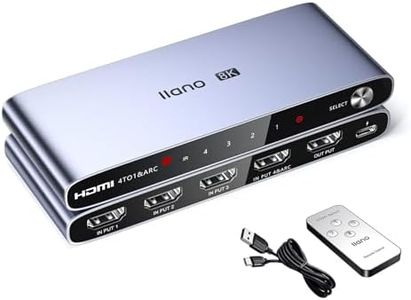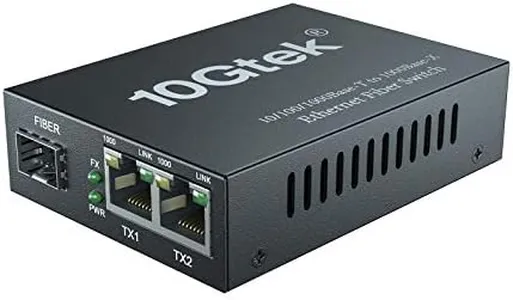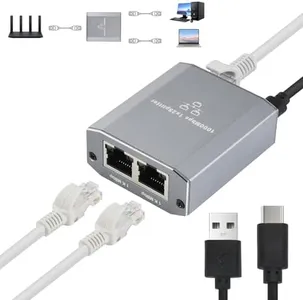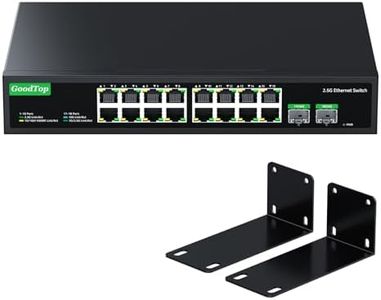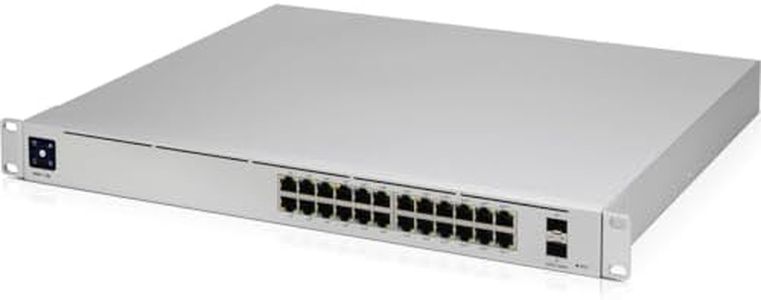10 Best Ethernet Switches 2025 in the United States
Our technology thoroughly searches through the online shopping world, reviewing hundreds of sites. We then process and analyze this information, updating in real-time to bring you the latest top-rated products. This way, you always get the best and most current options available.

Our Top Picks
Winner
Aruba a Hewlett Packard Enterprise company 6100 48G Class4 PoE 4SFP+ 370W Switch - JL675A#ABA US Localization/Cord
The Aruba 6100 48G Class4 PoE 4SFP+ 370W Switch is a solid choice for businesses looking for a managed Ethernet switch with a robust feature set. With 48 ports, it caters well to medium to large networks, allowing numerous devices to connect simultaneously. The Class 4 Power over Ethernet (PoE) support is a strong point, enabling power delivery to connected devices like IP cameras and VoIP phones without needing extra power sources. Additionally, the switch operates at layer 2, providing essential management features for improved network control and performance.
One of the highlights is its high switching capacity, which translates to efficient data handling across a busy network. The compact metal case also makes it durable, ideal for various environments.
However, being a managed switch, it may require some technical know-how to fully leverage its capabilities. Users who prefer a plug-and-play option without the need for extensive configuration may find this slightly challenging. Furthermore, while its weight is manageable, it's essential to consider the installation space, as it might take up more room than simpler, unmanaged switches. Lastly, the power capacity of 370W is impressive, but potential buyers should ensure this meets their specific needs, especially if they plan to power multiple devices.
The Aruba 6100 48G is an excellent option for network environments where management and PoE capabilities are essential, but it might not be the best fit for users seeking a straightforward, unmanaged solution.
Linksys LGS352MPC 48 Port Gigabit Network PoE+ Switch @ 740W with 4 x 10G Uplink SFP+ Slots - Advanced Security, QoS, Static Routing, VLAN, IGMP Features - Metal Housing, Desktop / Wall Mount
Most important from
17 reviews
The Linksys LGS352MPC is a powerful managed ethernet switch designed to support larger networks requiring many connections and reliable performance. With 48 Gigabit Ethernet ports, it allows you to connect numerous devices such as surveillance cameras, access points, and other office or business equipment. It also includes 4 high-speed 10 Gigabit SFP+ uplink ports, which help maintain fast data transfer and reduce slowdowns when connecting to your main network or servers.
This switch supports Power over Ethernet (PoE+), enabling it to deliver both data and power through a single cable to compatible devices, reducing the need for extra wiring. It provides up to 740 Watts of power, sufficient for many PoE devices simultaneously. As a managed switch, it offers advanced controls like traffic prioritization (QoS), VLAN setup, and security features, allowing you to customize network access and optimize performance, especially useful in business or security system environments.
The metal housing and options for desktop or wall mounting make it durable and adaptable for different installation needs. It also comes with a solid 5.5-year warranty and 24/7 technical support, adding peace of mind. However, this switch is relatively heavy (about 12.7 pounds) and may be more complex than what a small home network requires. Its advanced features cater more to business or professional environments rather than casual users. The price also reflects its business-grade capabilities, making it less suitable for those needing only a simple or unmanaged switch. If you need to connect many PoE devices with strong control, security, and high data speeds, especially in a small to medium business environment, this Linksys switch is a fitting choice. For simpler networks or budget-conscious users, a smaller or unmanaged switch may be easier to manage and more cost-effective.
Most important from
17 reviews
Juniper EX Series Etherenet Switching (EX3300-48T)
Most important from
4 reviews
The Juniper EX3300-48T is a solid choice for users needing a reliable ethernet switch. It comes with a total data transfer rate of 1000 Megabits Per Second and a significant 176 Gbps switching capacity, ensuring that it can handle substantial network traffic efficiently. With a port count of 48 and an additional four SFP ports, it is well-suited for medium to large-sized networks that require robust connectivity options. Its 1 rack unit form factor makes it easy to integrate into most server racks, saving on valuable space.
Additionally, the device runs on Junos operating system, which is known for its stability and advanced features. Another plus is that it supports both managed and unmanaged configurations, providing flexibility based on user needs. However, it's important to note that this model does not support Power over Ethernet (PoE), which might be a drawback for users looking to power devices like IP cameras or VoIP phones through the switch. Its weight of 13 pounds could make it somewhat cumbersome to handle during installation. Released in 2011, it is a bit dated, but it remains a viable option for those who need reliable performance without the latest features.
Best suited for business environments needing a dependable network switch with ample ports and solid performance.
Most important from
4 reviews
Buying Guide for the Best Ethernet Switches
Choosing the right Ethernet switch for your network can significantly impact the performance and reliability of your connections. Ethernet switches are essential devices that connect multiple devices within a local area network (LAN) and manage data traffic efficiently. To select the best Ethernet switch for your needs, you should consider several key specifications that will determine how well the switch will perform in your specific environment.FAQ
Most Popular Categories Right Now
